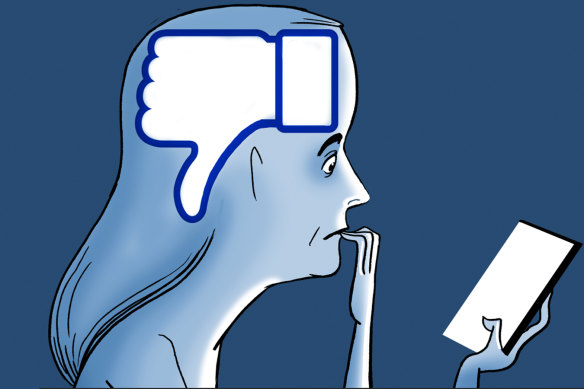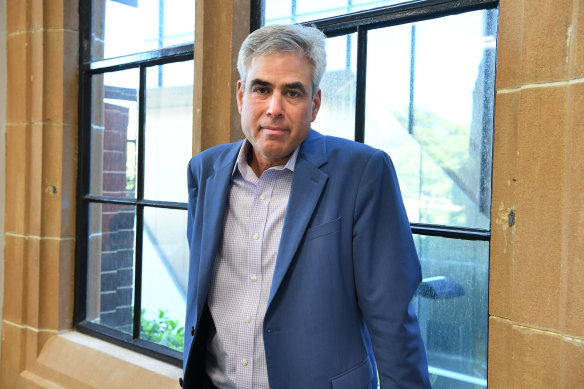This was published 1 year ago
Opinion
The charts that prove social media has bigger dangers than Elon Musk’s ego
David Crowe
Europe correspondentSocial media has a much bigger problem than Elon Musk. The American billionaire is railing against the Australian government and refusing to take down a violent video of the knife attack at a western Sydney church, while complaining about the “woke mind” and claiming to stand for free speech.
The furore is wonderful for Musk’s ego. The attention could be better than drugs. But here’s the truth: Musk is a small player in a big argument about social media. His site, X, has about 550 million active users each month, while Facebook has more than 3 billion and Instagram has 2 billion.

Illustration: Simon LetchCredit: Supplied
That makes Mark Zuckerberg, the Meta boss who runs Facebook and Instagram, a far greater power in changing our world. Not to mention the owners of TikTok, which has at least 1 billion monthly active users and is growing fast. Or Snapchat, with 750 million.
The argument about the violent video is urgent and important. But what if the greater danger is slow and insidious? What if social media apps, running on smartphones, are inflicting lasting damage on young children?
That is the warning in a new book about a disturbing increase in depression and anxiety after the arrival of the iPhone in 2007 and the explosion in social media apps soon afterwards. The Anxious Generation is by social psychologist Jonathan Haidt, a professor at New York University’s Stern School of Business. It is a good book, and it warrants a serious debate.
Haidt cites case studies like Alexis Spence, who found an easy way to get around her parents when she wanted to sign up for Instagram. She lied about her age, got the app and used a common trick to hide it on her home screen. Aged 11, she leapt into an exciting but sometimes toxic world. A decade later, she is one of thousands of Americans suing Zuckerberg’s company for damaging their mental health.

Jonathan Haidt argues that social media’s impact has been most pronounced among girls because they use the platforms more.Credit: Peter Rae
Aren’t parents responsible for their kids? Yes, of course. But we all know that children will sneak past parental controls. In any case, parents may choose to give their kids an iPhone to stay in touch with friends. It has taken time to shatter the illusion that the product is safe.
Haidt tells this story with charts that prove the harm to young people. He shows increases in major depression among teens, mental illness among American college students, anxiety among the young and suicide rates for young adolescents.
What is happening? Haidt blames smartphones and social media for “rewiring” childhood. One example is the way Instagram intensifies the visual comparisons a girl will make when bombarded with (altered) images of attractive women. Another is the way boys can be absorbed in violent games and porn, isolating them from the real world.
“The first generation of Americans who went through puberty with smartphones (and the entire internet) in their hands became more anxious, depressed, self-harming and suicidal,” Haidt writes.
“No other theory has been able to explain why rates of anxiety and depression surged among adolescents in so many countries at the same time and in the same way.”
Crucially, the charts show these mental health pressures grew worse long before the pandemic. Haidt cites figures from the United Kingdom, Canada, Scandinavia and Australia that tally with the US experience.
Is he right? Well, his references to Australia appear to be accurate. The Australian Institute of Health and Welfare, a federal agency that tracks healthcare trends, publishes results that match the trends in Haidt’s book.
The Australian agency reports a sharp rise since 2013 in the number of people aged over 16 with high or very high psychological distress, especially among young women. It reports an increase in mental health hospitalisations among the young, also worse among girls and women. The rate of admission was 54 for every 10,000 people in 2007 for females aged from 12 to 24. The rate doubled to 101 in 2020.
There was also a big rise in young people contacting community mental health providers over the same period. Among females aged from 12 to 24, for instance, the amount of contact was about 400 per 1000 people – a way of measuring cries for help. By 2020, this ratio had jumped to about 700.
I have included these charts in the online version of this column because the numbers tell the story so much better than words. While the figures for young women are especially dire, the Australian reports also show an increase in mental health challenges for young boys.
The challenge for Haidt and his argument, however, is not hard to see. Correlation is not causation. The public data shows that things changed after young people gained access to smartphones and social apps, but the data does not prove the cause. Candice Odgers, a psychology professor at the University of California, faulted Haidt on this in Nature last month.
“Hundreds of researchers, myself included, have searched for the kind of large effects suggested by Haidt,” she wrote. “Our efforts have produced a mix of no, small and mixed associations.” One of her arguments is that people with mental health pressures may respond to this by intensifying their use of social media.
Haidt argues the causal connection is being proven as more research is done. One example: girls aged 14 who spend five hours or more on social media each day are three times more likely to be depressed than girls who use social media only a little or not at all. Another: the risk of depression increases by 13 per cent for each hour an adolescent spends on social media. The links to this research are in Haidt’s blog. There is a very good analysis of this debate by Zoë Schiffer in the online publication Platformer.
The truth for the big tech companies is that they know they are selling a risky product to young buyers. Former Meta executive Frances Haugen went public about this three years ago by releasing internal documents on the problem, including one that said this: “Teens blame Instagram for increases in the rate of anxiety and depression. This reaction was unprompted and consistent across all groups.”
When yet another woman is raped, or dies at the hands of a violent partner, is it merely a moral panic to worry that boys can grow up saturated in online violence and pornography, including the two things in the same video? The public campaigns about respect for women are clearly failing to do enough good. It is logical, not alarmist, to look at the devices that mould young minds.
Haidt has four solutions. First, no smartphones before high school. Second, no social media before the age of 16. Third, a ban on smartphones at school. Finally, more time for children to play in the real world without being smothered by adult supervision.
In today’s world, those four steps look incredibly challenging, but not extreme. Many parents agonise about when to give their children smartphones, so they might welcome his advice. It would be a huge task to ban phones in schools, but Federal Education Minister Jason Clare already says this should happen. And who doesn’t want kids to have more time for independent play?
Putting an age limit on social media, however, is a bold idea that would infuriate a powerful industry. In theory, sites like Facebook, Instagram and TikTok expect users to be 13 and over. In reality, they do not care as long as subscriber numbers grow. They would howl with rage at any edict that wiped away a huge part of their customer base.
Haidt puts it this way in a blog post: “If you listen to the alarm ringers and we turn out to be wrong, the costs are minimal and reversible. But if you listen to the sceptics and they turn out to be wrong, the costs are much larger and harder to reverse.”
This debate blurs the lines of partisan politics. Many conservatives admire billionaires like Musk, but the alarm about social media is turning other conservatives against him and his ilk. The argument cuts across the default ideological positions on big government or limitless personal freedom. One reason is that this is about public health.
The Australian debate is already messing with the usual party divide. Labor, seen as the party of big government, is unsure about whether to require proof of age for social media sites. The Liberals, the small government champions, are now advocating this age verification.
Political leaders on both sides of the divide are reading Haidt’s book, for good reason. The data confirms a dire problem for young Australians. The moral response is to find a consensus in Canberra on how to act.
David Crowe is chief political correspondent.
The Opinion newsletter is a weekly wrap of views that will challenge, champion and inform your own. Sign up here.